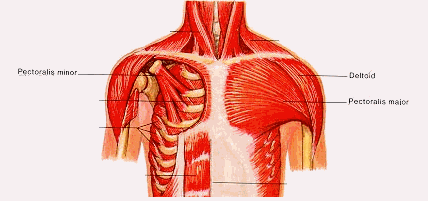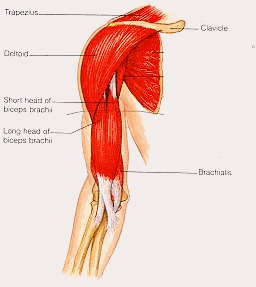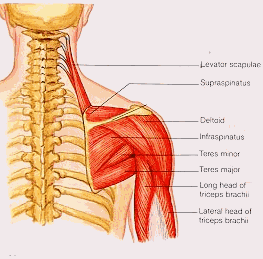|
on Freestyle Swimming July 7, 1998 The freestyle, or front crawl, is both the fastest and the most efficient swimming technique. When it was introduced more than a hundred years ago, many thought the stroke was too exhausting to be used for any distance longer than short sprints. But today it is used exclusively for races. Swum properly, the freestyle uses less energy than any other stroke. Technically, the name for the fastest of all strokes is the front crawl. Freestyle literally means the swimmer can swim any stroke, or any combination of strokes: backstroke, breaststroke, and butterfly, sidestroke, or elementary backstroke. But in modern swimming, freestyle has come to be synonymous with the crawl. Not only is the freestyle fast and efficient, most people find it the easiest stroke to learn. It is no surprise that it is the most popular stroke. Although it may look simple freestyle is a very complex stroke as can be noted by my discussion of the major components of the stroke, varying muscles that are utilized, scientific principals, and instruction for the novice swimmer. The freestyle has roots that go back thousands of years. An ancient Egyptian wall relief clearly shows soldiers of Ramses II using an over-arm stroke to pursue their Hittite enemies across the Orontes River more than 3,200 years ago. It has been recorded that Portuguese explorers of coastal Brazil, near modern-day Rio de Janeiro, noted that the local Indian's also swam with an overhand stroke. Over time, it seems that people became more and more proficient, eventually developing a form of crawl stroke. It was Australians, however, who first adopted and then refined the technique they observed among their island neighbors. Probably the most athletic people in the world, the Australians have always been particularly fond of swimming. In 1893 a man named Harry Wickham introduced the crawl in Australia. "It seems that Wickham had learned the stroke while visiting the island of Rubiana. He taught it to his twelve-year-old brother, Alick, who caught the eye of George Farmer, a local swim coach. The story goes that Farmer, stounded by the boy's speed and his unorthodox technique, exclaimed, "Look at that bloke crawling on the water!" The name stuck, and the modern era of swimming was born." (1:102) In 1902 two Australian brothers, Syd and Charles Cavill, presented the stroke in Europe. The following year they came to the United States, where the stroke was named the Australian crawl. The Cavills' Australian crawl featured a two-beat flutter kick: two kicks for each arm cycle. American swimmers promptly improved on it, substituting a faster four-beat kick. Since then the stroke has become progressively faster. In the freestyle, the arms stroke alternately - first one arm, then the other - recovering over the water, while the legs maintain a streamlined body position and provide additional propulsion with a constant scissors type kick also known as the "flutter" kick. Because of this, the front crawl is the fastest and most efficient stroke of all. The crawl stroke is also the easiest to learn for most people because the opposition of the arm and leg movements is quite similar to that of walking. This is the familiar hand-over-hand motion that is the basis of the crawl stroke. In the crawl stroke, the arms provide about 80 percent of the propulsion - more than in any other stroke. So using the arms as efficiently as possible is very important. The freestyle arm stroke consists of five phases: "The two most important principles to remember while swimming the front crawl is: 1. Always keep the elbows high, and 2. Accelerate the hand speed until completion of the follow-through. These are the two most common errors made by swimmers doing the front crawl." (2:103) The Entry The arm enters the water directly in front of the shoulder, with the elbow bent so it is higher than the hand. The hand enters at about a thirty-degree angle as "quietly" as possible; the key is to try to avoid slapping the water. 
Taken from 4:98 The fingertips enter first, thumb down, and the palm tilted out slightly. Then the arm slides forward and slightly downward, until it is fully extended. The Catch The catch is made as soon as the elbow is completely extended. As the elbow begins to flex, the wrist should turn downward so that the fingertips point toward the bottom of the pool. The hands should scull out slightly before beginning the pull. Although doing this is not necessary, coaches and swimmers will argue that it improves their pull. 
Taken from 4:97 The Pull The pull should start as soon as a "catch" of the water is made. As the pull begins the hand, forearm, and upper arm will grab an armful of water, almost as if it is reaching around a very large barrel, always remembering to keep the elbow high move the hand backward in an S-pattern, past the shoulders and then under the body. Remember not to let the pull cross the body's centerline, as this will disturb the body position. As the hand passes beneath the shoulders, the elbow achieves its maximum bend - about ninety degrees. 
Taken from 4:97 The Follow-through Throughout the pull, the hand accelerates to increase the body's speed. Now, in the follow-through, continuing that acceleration, the hand should push past back the hips. This should be a hard-accelerated push. As the arm straightens and extends to finish the stroke the palm should be facing the feet. This will allow the hand to exit the water most easily. 
Taken from 4:98 The Recovery The final phase of the arm stroke, the recovery, is a smooth, rounded movement in which the stroke continues into the air. It begins as the elbow leaves the water, followed by the shoulder and then the hand. The elbow should remain higher than the hand throughout the recovery, and the hand should be just over the surface of the water. The elbow should be the highest point over the body. The arm should remain completely relaxed throughout the recovery. Allowing momentum to carry it forward. As the recovery is completed, the hand enters the water again at about a thirty-degree angle, fingertips first, thumb down, palm tilted out. 
Taken from 4:97 An essential part of swimming the crawl stroke efficiently is the body roll. In fact, if the stroke is done correctly, there will actually be more spent time on the side rather than in a flat position. The roll is a natural motion caused by the rotating of the arm. It reduces drag, allows the large muscles of the back and shoulders to be put to their best use, and helps to get more distance with every stroke. It also makes recovery more relaxed and lets breathing without twisting the head. When the right arm enters the water, the body, especially the hips, rolls forty-five degrees to the right. Then, when the left arm comes around, the hips will roll forty-five degrees to the left. This will roll even more when breathing. "A new theory of how power can be maximized in the freestyle argues that swimmers need to roll even more than forty-five degrees. Using frame-by-frame underwater video and computer analysis, Bob Pritchard, director of Somax Posture and Sports in Corte Madera, California, analyzed the strokes of world-class, collegiate, and beginning swimmers. He found that the very best swimmers rotate their hips up to sixty degrees and that the hip movement precedes the arm stroke." (5) Thus, just as with baseball players and golfers, great power is generated from the hips, almost as much as from the shoulders and arms." (1:109) Since peak force in freestyle is produced by the rotation of the hips. Swimmers who were trained to improve their hip rotation won nine gold medals at the Atlanta Olympic games. While analyzing underwater tapes of elite swimmers, analysts also discovered that a lot of power in swimming really comes from the hip muscles. This finding was immediately confirmed when advancing the timing and increasing the speed of hip rotation reduced stroke count by 20% or more. Measurements made by Coach Thornton on his top swimmer, Matt Biondi, further confirmed this theory. While Biondi, the World Record holder at the time, produced 10% less power with his arms than other sprinters on the team, he was able to produce 70% more power with his hips. Measurements made by Somax showed he also had 70� more range of motion in his shoulders than any other swimmer on the team. Somax finished its consulting with Berkeley in the fall of 1987. In the spring of 1988, coach Thornton asked Somax to return to Berkeley to analyze Biondi as he had been losing races in the 100m free, for which he held the five fastest times in the world. Videoanalysis showed that Biondi had reduced his hip rotation on his left side by just 15�. Restoring that lost range and increasing the speed of his hip rotation enabled Biondi to drop his stroke count in training from 13 to 9. Three months later at the Olympic Trials in Austin he set a new World Record and then went on to win 5 Gold Medals, 1 Silver and 1 Bronze at Seoul. Somax was also asked to work with 8 elite swimmers in Colorado Springs in August 1995 who were preparing for the 1996 Olympics in Atlanta. Computer analysis conducted by researchers in Colorado Springs showed that swimmers who increased the acceleration of their hips doubled their peak hand force output. 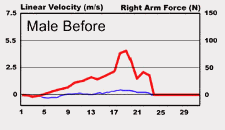
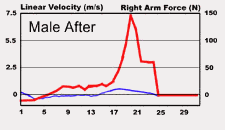
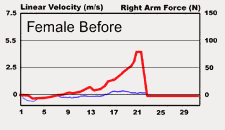
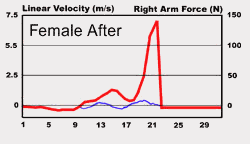
These graphs show that swimmers who increased the acceleration of their hips doubled the peak hand force (heavy solid line) they applied to the water after just one week of Somax training. You can see that neither swimmer produced much force until after they rotated their hips. The female sprinter was able to advance the timing of her hip rotation (thin, broken line) and thus doubled her insweep peak. The male sprinter delayed his hip rotation, and his initial hand force output was less. Then doubled his peak force as he accelerated his hips. The female sprinter won four Gold Medals and the male sprinter won two Gold Medals at Atlanta." (5) This clearly shows how important body roll is to swimming faster, but body roll will also make it easier to breathe. In order to breathe while swimming the front crawl, follow the body's natural roll. As the body rolls toward the breathing side, the head should turn gently and this should bring the face and mouth out of the water making breathing possible. By inhaling when the body naturally rolls lifting the head out is not necessary. The principle behind this is that breathing is actually done below the surface of the water. Forward momentum creates a bow wave extending from the head to the neck, leaving a small air pocket in which to inhale. In order to minimize time out of the water breathing, exhaling is done under water. To keep from breathing early the opposite hand should enter the water before turning to inhale. This is a common error that will be discussed later. Breathing can be done on the right side, the left side, or both sides, whichever is preferred. Most coaches prefer bilateral breathing which is inhaling alternately from both sides. Alternate breathing balances the stroke. Janet Evans, Olympic medal winner, usually breathes every third stroke alternating sides. The key is to have a rhythm in the stroke. Without breathing the body will go into oxygen debt. This will cause fatigue very quickly. 
Taken from 4:98 The leg action that accompanies the crawl stroke is called the flutter kick. The kick contributes only about 20 percent of the total propulsion in the freestyle, less than in any other stroke. Remember that the kick is not giving the same force as the hips are. The kick is essential in maintaining body position and preventing excess wiggling of the hips. To do the flutter kick, the legs move up and down alternately in a steady strong, consistent rhythm. The power for the kick comes from the hips, not the lower legs. As the leg moves downward, the knee should bend slightly and the ankle should be loose. On the upbeat, the knee should hold relatively straight and the foot should raise until the heel breaks the water surface. The foot should not come out of the water because a big splash contributes nothing to propulsion. The feet should only go about twelve to sixteen inches below the water surface. This will create a "boil" around the feet. There are several kicking patterns that can be used to keep a rhythm in the stroke. Generally speaking, sprinters use the six-beat kick, which has the advantage of generating more power but the disadvantage of using more energy. Distance swimmers tend to use some variation of the two-beat kick. This is something that is chosen by the swimmer depending on how it feels. Swimming utilizes many of the body's muscles, especially the front crawl. The upper body and the arms are the major contributors to the front crawl. The major muscles and there origins, insertions, and actions used in the front crawl are as follows: Arm/Upper body Pectoralis major Deltoid Rotator cuff Muscles include: supraspinatus, infraspinatus, teres minor, and subscapularis Brachialis
Rectus abdominis External and internal oblique Transversus abdominis 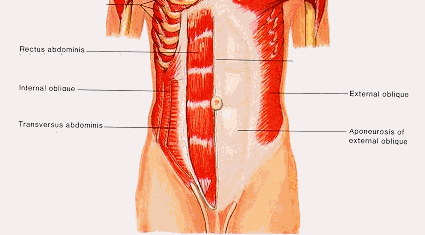
Taken from 6:49 Leg muscles Upper leg Tensor Fascia latae Vastus medialis and lateralis Rectus femoris All lower leg muscles make the leg move up and down, aiding in the kick. Lower leg Tibialis anterior Gastrocnemius Soleus Extensor digitourm longus Flexor digitorum longus 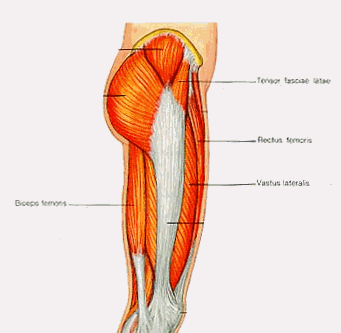
Taken from 6:51 These are the muscles used to make swimming the front crawl possible. These muscles all work together to move the swimmer down the pool. Competitive swimmers are always trying to improve the time it takes them to get from one end of the pool to the other. This formula is what it looks like all together. tTotal = tStarting + tStroking + tTurning (7:345) The time that a swimmer spends stroking is completely determined by two factors: the distance involved and the average speed of the swimmer over that distance. Assuming that the swimmer follows an essentially straight course, the distance of the race primarily dictates the distance involved. It is also influenced to some small extent by the location of the point at which the swimmer begins stroking at the start of the race, the points at which stroking ceases before the execution of the turns, and the points at which stroking resumes following the turns. (7:347) The average speed of the swimmer is equal to the product of two factors:
DPS = Distance stroked / number of complete arm cycles Example: if you take 12 strokes down a 25 yard pool your DPS is: DPS = 25 yards / 12 strokes DPS = 2.27 yards/stroke SR = number of complete are cycles / time spent stroking Example: if you take 12 strokes in 11 seconds your SR is: SR = 12 strokes / 11 seconds SR = 1.09 strokes/second Stroke length: The stroke length is governed by the forces exerted on the swimmer - the propulsive forces, which drive the swimmer forward through the water in reaction to the movements the swimmer makes, and the resistive forces, which the water exerts on the swimmer to oppose that motion. It has been predicted that swimmers derive between 70% to 85% of their forward speed from their arms and the rest from the legs. Some people will argue that the only source of power in the front crawl is from the arms. Some say that the legs only act as a way for the body to balance itself as it rolls. It really depends on the swimmer as to how the legs help. Swimmers that use an 8 beat kick get much more power from the legs. The downfall of this is that it takes much more energy to kick this much. This is why distance swimmers usually use a 2 beat kick and sprinters generally use an 8 beat kick. It takes much more energy to kick with an 8 beat kick causing the swimmer to tire much faster. "Two studies n which swimmers were tethered to devices that recorded the forces they exerted while swimming "on the spot" shed some light on the relative contribution of the arms in strokes other than the front crawl. In the first of these, Mosterd and Jongbloed found that the forces exerted by the arms was much greater than the legs. The arms provide the major portion of the propulsive force." "While the importance of the arms as a source of propulsion has long been recognized, it is only over the last 20 years that the manner in which this propulsive force is obtained has become reasonably well understood. Prior to this time, it had generally been considered that the drag force exerted against the swimmer's arms, in reaction to efforts to move them directly backward, were responsible for the swimmer being propelled forward. Thus, articles and texts on swimming routinely emphasized the importance of the arms being pushed horizontally backward through the greatest distance possible. However, in two classic papers published in 1971, Counsilman and Brown suggested that lift rather than drag may be the principal source of the propulsion generated by the arms." (7:349) In the front crawl the hands move backward relative to the shoulders. The shoulders themselves are moving forward at approximately the same rate. The general impression, that the hands move backward through the water is more apparent than real. If the swimmer's palms face outward and backward as the hands move outward in the pulling phase of the stroke, the resultant force exerted by the water on each hand will be in an inward and forward direction. If the hands are moving in a direction at a right angle to the direction of the swimmer's motion, the lift component of this resultant force acts in the direction in which the swimmer is moving and thus serves to propel the swimmer forward. The drag component acts at right angles to the direction, in which the swimmer is moving and thus has no effect on the forward motion. During recovery, the palms are directed inward and backward and the lift component of the resultant force on each hand once again acts to propel the swimmer forward. This shows that lift plays a prominent role in propelling the swimmer through the water. There are three useful functions that the kicking actions of the legs may serve:
During the insweep, earlier discussed as the pull, the hand is predominantly in a medial and somewhat backward direction. In this part of the pull, the resultant force on the hands acts in a forward or near-forward direction and both the lift and drag components of the resultant force make substantial contributions to the swimmer's forward propulsion. During the upsweep, earlier discussed as the follow-through, the hand is predominantly in a lateral backward, and upward direction. The resultant force on the hands acts in a forward, downward, and frequently medial direction. Both lift and drag components can make substantial contributions to the forward propulsion during this phase but, in general, the contribution of the lift component tends to dominate. During the kick, the function of the legs has generally been accounted for in terms of drag. By thrusting the leg downward and backward the resulting propulsive effect has been assumed to derive from the horizontal component of the drag force acting on the legs. The Laws of Swimming Newton's first law: A body at rest tends to stay at rest, a body in motion tends to stay in motion, unless it is acted upon by some external force that will affect the motion by the magnitude and direction of the applied force. When swimming the body glides through the water. If one were to stop stroking, while swimming, the body would still glide in the direction that it was originally moving. Newton's second law: A body will be accelerated directly proportional to the force acting upon it and inversely proportional to the body's mass. Pulling the arm through the water causes acceleration. When pulling through the water the arm is putting pressure on the water and the water is putting pressure back on the arm, thus causing acceleration. As the arm puts force on the water the water puts a force inversely proportional to the body's mass. Newton's third law: For every action there is an equal and opposite reaction. The action of stroking, putting the arm through the water causes the body to be accelerated forward. As the palm catches the water and puts force on the water, the water puts force on the palm causing the body to be accelerated forward. Equations
Work done can be calculated by the amount of force the arms and the legs put on the water multiplied by the distance swum. Power can be calculated by taking the work done and dividing it by the amount of time swum. An impulse can be calculated by the amount of force the arms and the legs put on the water multiplied by the time period swum. This will produce the change in momentum produced by the force: the product of the average value of a force and the time during which it acts. Linear momentum can be calculated by taking the bodies mass and multiplying it by the velocity of the swim. Take the force that the arm is putting on the water and divide it by the area of the arm and the result will be the pressure. Third class The only lever that applies to the front crawl is the third class lever. The deltoid, in the case of the upper body, is the fulcrum. The force is given from the deltoid and the resistance is the water. In the case of a third class lever, resistance and force move in the same direction. There is a loss in mechanical advantage because it takes a tremendous amount of energy to pull enough water to accelerate the body. The positive part of a third class lever is the gain in distance and speed of movement. Example: 3-inch deltoid, 31-inch arm, pulls 11 pounds 3 inches * F = 33 inches * 11 pounds 3F = 363 F = 121 pounds 121 pounds of force is put on the deltoid to move an 11 pound force. These are the laws that apply to swimming the front crawl. All these laws work together to make the body move as efficiently as possible through the water producing the fastest time possible in the pool. By understanding these laws it makes it much easier to understand and teach the front crawl to all levels of swimmers. There are many different ideas on how to teach the front crawl to a novice swimmer. The most important key is not to over explain things, causing them to get bored and lose attention. Kids see a smaller world then adults, their main goal is to do what is fun. Making learning fun is the best way to keep just about anyone's attention. One way is to start by teaching the novice how to breathe. Breathing is one of the key components to the front crawl because, unlike other sports, you cannot breathe under water. Breathing in the front crawl is essential because the swimmer will be slowed down if breathing is not done properly. One of the first steps is having the novice stand in shallow water and have them turn their head from side to side, breathing at the side and exhaling in front of the body. The second step is to have them get their face wet up to their hairline, turning their head when they need a breath and exhaling under water by blowing bubbles. By always stressing the turning of the head to the side when inhaling and exhaling underwater, it will soon come naturally. Once this skill is mastered it is time to move to the kick. Some common errors a novice might have when learning how to breathe:
To start kicking have the novice sit on the side of the pool and move their feet up and down. Explain that it is like running while lying down. A common error here is many children and adults try to "ride a bike" with their legs. This will make the swimmer slower causing them to get frustrated and lose attention. Have them turn their head to the side whenever they want to breathe, making it a game, helping to keep interested. Once things look good out of the water, have the swimmer hold their hands on the side of the pool and kick, making a small splash. Next have them do it with the face in the water up to the hairline. Whenever they need to breathe they should turn their head to the side. Some common errors that a novice might make when kicking:
Teaching a beginner to pull is one of the most difficult parts, besides putting the whole stroke together. Teaching this part is actually done easiest on a diving board so the swimmer can see their hands below them. Have the swimmer lie in a prone glide position, with the arms extended forward, have them flex their wrist so their fingers point down, and the palm is facing back. Have them begin the pull with the forearm and hand, keeping the elbow high. Have them bend the elbow backward, straightening the wrist as the forearm moves. They should now have the hand in the centerline of the body, directly under the nose and the elbow should be bent at 90 degrees with the wrist straight. Have the swimmer pretend that they are pushing water back behind them. As they push past their waist, they should start to straighten the elbow, allowing the hand to move outward to the right thigh. They should let their thumb touch the thigh. Once the thumb touches the thigh, they should begin the recovery. At this point the elbow should start to bend toward a 90-degree angle as the hand scrapes gently above the imaginary waterline. During the recovery, the hand should lead slightly in front of the elbow, eventually to a full arm extension. At this point the palm should be facing downward and attention should be placed at the opposite arm. Once the out of water beginning is mastered, it is time to try it in the water. By following these steps the novice can learn proper techniques, such as the S curve, high elbows and body roll. Bad habits are very hard to break, learning them correctly makes it much easier in the long run. Here are some errors that beginners can have.
Once the pulling and kicking is mastered, it is time to add the breathing component. As long as the teacher has stressed turning the head to breathe, it shouldn't be too hard for the swimmer to learn. To begin, start in the prone position, pulling a stroke or two and exhaling until the arm on the breathing side begins to pull. Start the swimmer by turning the head up for a breath while the arm is making the first half of the pull. The swimmer will realize that their mouth will be free to take a breath. Instruct them to take a quick, but full, breath and return their face back to the water as the breathing-side arm begins its recovery. Remind them to exhale during the pull and recovery of the non-breathing-side arm.
When teaching the front crawl to anyone you must first realize whom you are teaching too. If you are teaching a young novice you must realize that they probably don't have the attention span of an adult. They will get bored easily with over explanation. A child must be taught how much fun they are having and how much fun they will have when they have mastered the skill. An adult might have questions why you are teaching them what they are doing. You must be prepared to answer why with a valid explanation. If you understand why you are doing it you will be able to do it much easier. When teaching someone who has already mastered the stroke it usually helps to use stroke drills to correct technique. When you are correcting a master swimmer, you are usually trying to correct bad habits. Some common errors of a mastered swimmer are:
Bad habits are easily formed and hard to break. Bad habits need to be caught early, because, like the cliche "It is hard to teach an old dog new tricks." Some excellent stroke drills to try and correct bad habits include:
For over 3000 years the front crawl has been recognized as a form of swimming. Everyone is always trying to improve it and make it more efficient to have that slight edge on the competition. The purpose of this paper is to try and explain not only how the front crawl is done, but why it is done and the muscles that are used in swimming it. Once the front crawl is mastered modifications can always be made to improve it by doing stroke drills. With hard work, determination, dedication, and good coaching swimming the front crawl can be fun as well as the fastest stroke known to the sport of swimming. Works Cited
| ||||||||||||||||||||||||
